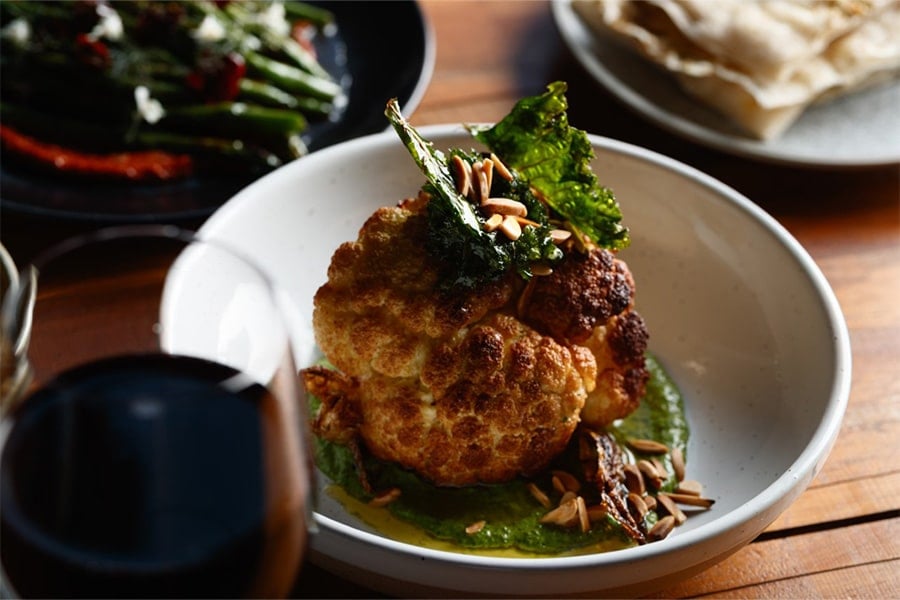
If you’ve ever wondered why you crave or respond to foods differently throughout your monthly cycle there’s a reason… your hormones. Over the course of the month, those who have a menstrual-ovulatory cycle experience various hormonal changes that can impact behaviour, motivation, mood, cravings and metabolic function. Your hormones can impact what foods you feel like, or actually need, and vice versa your foods can impact your hormones. Here, we're planning to unpack how you can best optimise your diet to help you through the different stages of your cycle.
The four phases of the menstrual cycle:
The menstrual-ovulatory cycle is typically thought to be an average of 28-days but it can be shorter or longer than this depending on the individual.
There are 4 phases of the menstrual cycle:
1. Menstrual Phase (Day 1-5)
- Your bleed marks Day One of your cycle
- A menstrual bleed is triggered by a decline in the hormone progesterone (pro-gestation or pro-pregnancy) when a pregnancy isn’t achieved
- Bleeding days and heaviness of your menstrual bleed varies person to person
- If you are on the oral contraceptive pill (OCP) then your bleed days are not a period or menstrual bleed, they are a withdrawal or pill bleed.
2. Follicular Phase (Day 6-13)
- This pre-ovulatory phase is from the end of your menstrual phase until you ovulate
- Oestrogen is the dominant hormone during your follicular phase and works with FSH (follicle stimulating hormone) to begin the selection process of the egg released during ovulation.
3. Ovulatory Phase (Between Day 10-14)
- During the ovulatory phase the dominant egg is released (ovulation) which is triggered by a specific hormone - luteinising hormone (LH)
- Ovulation is the “main event” in the cycle and often when you’ll feel your best, with higher energy and a higher libido.
4. Luteal Phase (Days 14-30)
- The major hormone in the luteal phase - progesterone - helps the endometrium to thicken and ready itself for conception
- During this phase your metabolism increases requiring more energy input i.e. nutritious foods
- It’s also during this phase that with the natural decline of oestrogen occurs and you can experience low energy, cravings, bloating and PMS
- Your metabolism is higher, so you need more energy (aka food)
- If the egg released during ovulation isn’t fertilised, progesterone will drop and other hormones stimulate your menstrual bleed and the cycle starts over, you’re back at Day One.
If you understand how you can eat for different phases of your cycle, you can naturally improve energy, productivity, mood, and reduce some of the symptoms you don’t love such as PMS, headaches, painful cramping and bloating.
How to eat for your menstrual phase
Around 1mg of iron is lost during a menstrual bleed. Those with heavier bleeding, endometriosis, adenomyosis, fibroids, polyps and other causes of abnormal uterine bleeds can lose more iron. The WHO reports that around 1/3 of women worldwide are iron deficient which doesn’t come as a surprise.
You can navigate loss of iron by consuming iron rich foods such as slow cooked meats (beef, lamb, kangaroo, liver) darker cuts of poultry such as chicken thigh, tofu, lentils or black beans. When consuming plant based iron rich foods team them with a source of Vitamin C such as lemon, lime, tomato, or broccoli to improve the body’s absorption of plant based (non-heme) iron.
You may also benefit from including high magnesium foods to help reduce cramping like pumpkin seeds, almonds, legumes and spinach.
For those that suffer from period pain, anti-inflammatory spices like ginger and turmeric may assist also.
It’s worth considering the foods to avoid during the menstrual phase as well. By reducing / avoiding certain foods you can reduce symptoms such as cramping, headaches and inflammation. Try to avoid coffee and foods high in refined sugars such as cakes, biscuits, lollies etc.
How to eat for your follicular phase
During the Follicular Phase you’ll often feel light, energised and motivation increases - what a combo! Oestrogen is powerful like that. For those who have excess oestrogen, it can cause issues in the next phase of their cycle.
In the instance of oestrogen excess (assessed by running lab tests and support from your allied health professional) focus on fibre rich foods and cruciferous vegetables like broccoli (especially broccoli sprouts) to support bowel and liver clearance of excess oestrogen.
If low oestrogen is your concern, flaxseeds are fantastic for boosting oestrogen levels. Adding some ground flaxseeds to your smoothie or breakfast bowl is an easy way to get them in.
Tolerance to carbohydrates is better during the follicular phase. Focus on fibre rich wholefood carb sources such as quinoa, buckwheat, wholegrain bread or pasta, rolled oats and corn, to help with bowel clearance of oestrogen but also to refuel glycogen stores. It’s worth noting, you may not feel like a lot of carbohydrate during this phase because your energy is great, but some is of course still highly beneficial.
If you are planning for a pregnancy, avoiding alcohol in this phase is important as it can interfere with ovulation. Alcohol can also increase oestrogen so those that suffer from oestrogen excess may benefit from refraining.
How to eat for your ovulatory phase
This is what we call “the main event”, many people report they feel their best during this window. Ovulation is the time your hormones are at their peak for the cycle. This leads to more energy, high libido and increased productivity. Focus on high quality proteins such as salmon, trout, tuna, grilled chicken, lentils, chickpeas, butter beans combined with low starch fibre rich foods e.g leafy greens, steamed vegetables to ensure healthy oestrogen clearance and hormonal balance.
How to eat for your luteal phase
Progesterone dominates during the Luteal Phase and depending on whether you’re in early stage pregnancy or continuing your cycle it can impact how you feel. If a pregnancy is not achieved, you will experience a gradual drop off in hormones which will then trigger your menstrual bleed and you’re back at Day One.
If pregnancy is your goal, incorporate plenty of folate rich foods like green leafy vegetables such as cooked spinach, kale, silver beet, peanuts, sunflower seeds and eggs. Meeting folate requirements in the early stage of pregnancy is vital to support the development of your baby’s neural tube. The neural tube is the tissue structure that encloses your baby’s spinal cord and brain. Studies have also shown that women who get adequate folate prior to pregnancy are more likely to achieve a pregnancy. (This is why preconception nutrition and health is SO important.)
If you’re continuing your cycle without pregnancy as the goal, the hormonal decline in this phase can have some side effects. We know these side effects aren’t cast across everyone but many individuals experience mood changes, PMS, headaches, constipation or diarrhoea, and sore boobs just to name a few.
Nutrients which can help reduce these symptoms include:
- B6- found in dairy products, tuna, chickpeas, papaya and rockmelon
- Zinc – richest in seafood, shellfish, seeds and nuts
- Vitamin C- abundant in berries, broccoli, capsicum, kiwi fruit and tomato
- Magnesium- found in dark chocolate (remember to keep refined sugars low) wholegrains, leafy greens and legumes e.g. lentils, chickpeas, kidney beans
- Iodine - rich in seaweeds like nori wraps, nori snacks (toasted seaweed), dulse flakes and iodised sea salt
As progesterone increases your metabolic rate, you will need more food than other phases of your cycle, even just an increase of 200 calories per day from nutritious, whole food sources can really support this phase of your cycle. If are if you aren’t eating enough calories, very likely you will be experiencing some cravings. Focus on nutrient dense foods rather than quick sugary fixes.
Aim to reduce a few foods in the luteal phase such as coffee, refined carbs (like white breads and pastries), high sugar foods and excessive salt. Bloating is often a concern for many women in the lead up to their period so swap your daily coffee (or multiples) for caffeine free dandelion root tea, which is a natural diuretic helping to reduce fluid retention.
Want to learn more about how you can shift your lifestyle to help you better navigate your menstrual cycle? Read our article on cycle syncing.
For more nutrition advice from Jacqueline Alwill, visit Day One Fertility.
Image: courtesy of Universal Pictures.



